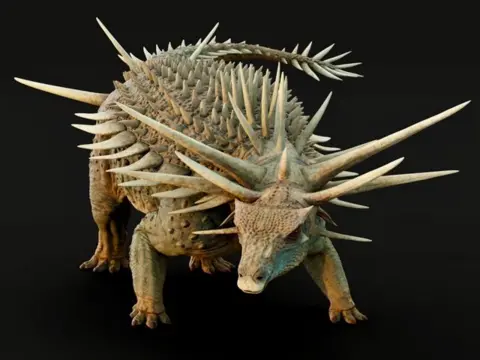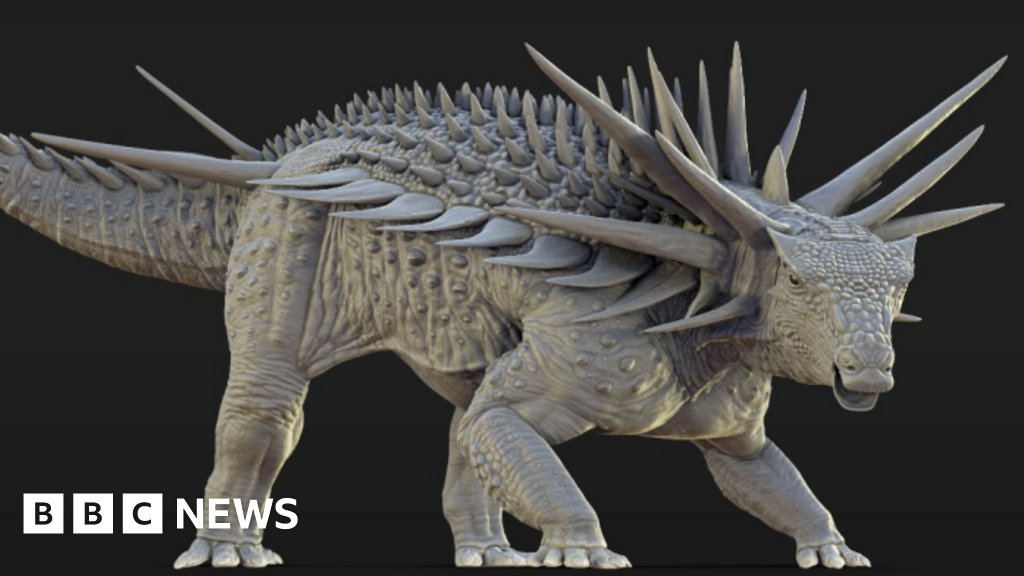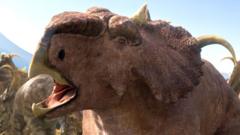Scientists have discovered a bizarre armoured dinosaur which had metre-long spikes sticking out from its neck. The species, called Spicomellus afer, lived 165 million years ago, and is the oldest example of a group of armoured dinosaurs called ankylosaurs. The elaborateness and spikiness of the animal found in Morocco has come as a shock to experts, who now have to rethink how these armoured dinosaurs evolved. Prof Richard Butler, from the University of Birmingham who co-led the research, told BBC News that it was the punk rocker of its time. Punk rock is a sub-culture and music style that first emerged in the 1970s. Its followers often have spiky hair and accessories. It is one of the strangest dinosaurs ever discovered, said Prof Butler. Prof Butler's project co-leader, Prof Susannah Maidment of the Natural History Museum, added that it was surprising that the spikes were fused directly on to the bone. We don't see that in any other animal, living or extinct, she said. It's absolutely covered in really weird spikes and protrusions all over the back of the animal, including a bony collar that wraps around its neck and some sort of weapon on the end of its tail, so a most unusual dinosaur, she said. The discovery is so unusual that the two professors are considering whether the discovery might force a rethink of theories on how ankylosaurs evolved. These animals survived late into the time dinosaurs were on Earth, in a period known as the Cretaceous between 145 and 66 million years ago. The end of this period saw the emergence of large carnivorous predators, such as T. rex, so it had been thought that ankylosaurs started off with simple small armoured plates on their back, which then became larger and more extensive to protect themselves from these big beasts, according to Prof Butler. If you had asked me what I would have expected the oldest known ankylosaur to look like I would have said something with quite simple armour, he told BBC News. Instead, we have an animal bristling with spikes like a hedgehog, the most bizarre armour that we've ever found in any animal, far outside the range of armour seen in later ankylosaurs. The researchers don't have enough of the skeleton to be sure of the animal's proportions, but they estimate it would have been about four metres long and one metre high, weighing around two tonnes. The discovery raises the possibility that ankylosaurs started off with elaborate armour in an earlier dinosaur period, known as the Jurassic, which evolved over tens of millions of years to become simpler and possibly more functional, according to Prof Maidment. What we are speculating is that maybe these structures were actually used for display, and it was only later in the Cretaceous when we start to see gigantic dinosaurs with huge jaws and crushing bites that they actually then needed to co-opt these display structures as body armour. The discovery was made by a local farmer in what is now the Moroccan town of Boulemane. It was the first ankylosaur to be found on the African continent. Prof Butler recalls the moment when he first saw the fossils. It was a jaw-dropping, spine-tingling moment, perhaps the most exciting in my career. It was clear right away that this animal was much weirder than we imagined and that we had enough of it to make sense of it, he said. The research has been published in the journal Nature.
'Punk Rock' Dinosaur with Metre-Long Spikes Discovered

'Punk Rock' Dinosaur with Metre-Long Spikes Discovered
A groundbreaking discovery in Morocco reveals a bizarre armoured dinosaur, named Spicomellus afer, that challenges prior understandings of ancient dinosaur evolution.
Scientists have unearthed Spicomellus afer, a peculiar armoured dinosaur boasting metre-long spikes, dating back 165 million years. This species, the oldest within the ankylosaurs group, has prompted experts to reconsider their theories on dinosaur evolution. Notably, the spikes are directly fused to the bone, a feature not observed in any other known species, suggesting unique evolutionary adaptations for display or defense in the face of predatory threats.



















